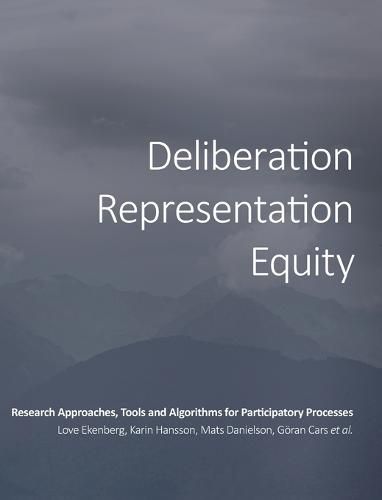Readings Newsletter
Become a Readings Member to make your shopping experience even easier.
Sign in or sign up for free!
You’re not far away from qualifying for FREE standard shipping within Australia
You’ve qualified for FREE standard shipping within Australia
The cart is loading…






This title is printed to order. This book may have been self-published. If so, we cannot guarantee the quality of the content. In the main most books will have gone through the editing process however some may not. We therefore suggest that you be aware of this before ordering this book. If in doubt check either the author or publisher’s details as we are unable to accept any returns unless they are faulty. Please contact us if you have any questions.
What can we learn about the development of public interaction in e-democracy from a drama delivered by mobile headphones to an audience standing around a shopping center in a Stockholm suburb?
In democratic societies there is widespread acknowledgment of the need to incorporate citizens’ input in decision-making processes in more or less structured ways. But participatory decision making is balancing on the borders of inclusion, structure, precision and accuracy. To simply enable more participation will not yield enhanced democracy, and there is a clear need for more elaborated elicitation and decision analytical tools.
This rigorous and thought-provoking volume draws on a stimulating variety of international case studies, from flood risk management in the Red River Delta of Vietnam, to the consideration of alternatives to gold mining in Rosia Montana in Transylvania, to the application of multi-criteria decision analysis in evaluating the impact of e-learning opportunities at Uganda’s Makerere University.
Editors Love Ekenberg (senior research scholar, International Institute for Applied Systems Analysis [IIASA], Laxenburg, professor of Computer and Systems Sciences, Stockholm University), Karin Hansson (artist and research fellow, Department of Computer and Systems Sciences, Stockholm University), Mats Danielson (vice president and professor of Computer and Systems Sciences, Stockholm University, affiliate researcher, IIASA) and Goeran Cars (professor of Societal Planning and Environment, Royal Institute of Technology, Stockholm) draw innovative collaborations between mathematics, social science, and the arts.
They develop new problem formulations and solutions, with the aim of carrying decisions from agenda setting and problem awareness through to feasible courses of action by setting objectives, alternative generation, consequence assessments, and trade-off clarifications.
As a result, this book is important new reading for decision makers in government, public administration and urban planning, as well as students and researchers in the fields of participatory democracy, urban planning, social policy, communication design, participatory art, decision theory, risk analysis and computer and systems sciences.
$9.00 standard shipping within Australia
FREE standard shipping within Australia for orders over $100.00
Express & International shipping calculated at checkout
This title is printed to order. This book may have been self-published. If so, we cannot guarantee the quality of the content. In the main most books will have gone through the editing process however some may not. We therefore suggest that you be aware of this before ordering this book. If in doubt check either the author or publisher’s details as we are unable to accept any returns unless they are faulty. Please contact us if you have any questions.
What can we learn about the development of public interaction in e-democracy from a drama delivered by mobile headphones to an audience standing around a shopping center in a Stockholm suburb?
In democratic societies there is widespread acknowledgment of the need to incorporate citizens’ input in decision-making processes in more or less structured ways. But participatory decision making is balancing on the borders of inclusion, structure, precision and accuracy. To simply enable more participation will not yield enhanced democracy, and there is a clear need for more elaborated elicitation and decision analytical tools.
This rigorous and thought-provoking volume draws on a stimulating variety of international case studies, from flood risk management in the Red River Delta of Vietnam, to the consideration of alternatives to gold mining in Rosia Montana in Transylvania, to the application of multi-criteria decision analysis in evaluating the impact of e-learning opportunities at Uganda’s Makerere University.
Editors Love Ekenberg (senior research scholar, International Institute for Applied Systems Analysis [IIASA], Laxenburg, professor of Computer and Systems Sciences, Stockholm University), Karin Hansson (artist and research fellow, Department of Computer and Systems Sciences, Stockholm University), Mats Danielson (vice president and professor of Computer and Systems Sciences, Stockholm University, affiliate researcher, IIASA) and Goeran Cars (professor of Societal Planning and Environment, Royal Institute of Technology, Stockholm) draw innovative collaborations between mathematics, social science, and the arts.
They develop new problem formulations and solutions, with the aim of carrying decisions from agenda setting and problem awareness through to feasible courses of action by setting objectives, alternative generation, consequence assessments, and trade-off clarifications.
As a result, this book is important new reading for decision makers in government, public administration and urban planning, as well as students and researchers in the fields of participatory democracy, urban planning, social policy, communication design, participatory art, decision theory, risk analysis and computer and systems sciences.